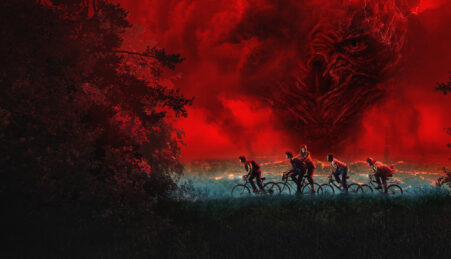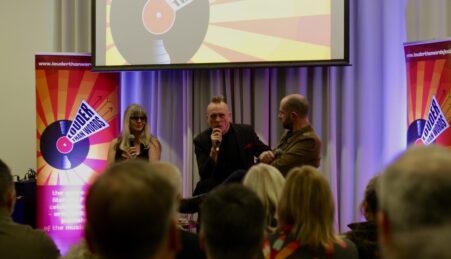By Jacqueline Grima
Manchester Metropolitan University launched its 2015/16 Humanities in Public Festival this week, beginning with an inaugural lecture by Professor of Human Geography, Craig Young. The lecture, entitled “Making a place for the dead: developing inter-disciplinary perspectives on contemporary encounters with dead bodies”, was also an opportunity for Craig’s colleagues to celebrate the work he has accomplished at MMU.
The event began with a wine reception before Craig was introduced by Professor Berthold Schoene, Head of Research at Manchester Metropolitan University. Craig then began by talking about society’s perception of death and how our relationship with death is changing in the modern world. According to Craig, this is due to its increasing presence in our lives through social media and television. For example, at one time, death was something that was hushed up and not talked about, whereas now we are able to regularly access images of death on the internet and through television programmes like Ripper Street and Silent Witness.

Professor Craig Young (Centre) Inaugural Lecture, Introduced by Prof. Professor Berthold Schoene with respondent Professor Douglas James Davies (Left)
Craig went on to discuss the tragic case of a young American, CJ Twomey, who sadly took his own life at the age of twenty. Aware of his desire to travel the world, CJ’s family subsequently set up a Facebook page called ‘Scattering CJ’ through which the public were able to access CJ’s ashes by post and scatter them in a place that they believed he would have liked to visit. CJ’s ashes have now been scattered in over 100 countries and have even being sent into space.
When asked by Humanity Hallows why it is important that we re-evaluate our perception of the dead, Craig said:
“In recent times, there has been a change in people’s relationship to the dead, be it their own personal dead or the dead in general. For example, there have been noticeable changes in modes of commemoration and remembrance, which seem to have shifted from large-scale, grandiose, more traditional cemeteries to smaller, more ephemeral ways of commemorating like roadside shrines and the use of ashes in tattoos and jewellery.
“We are also encountering the dead body much more often through popular culture and through the rise in popularity of what we call Dark Tourism.”
The concept of Dark Tourism, where people pay to have a guided tour of a cemetery or to see the grave of a famous person, was also emphasised by some of the guests at the lecture. Duncan Light, Tourism Management Lecturer at Bournemouth University told Humanity Hallows:
“I am currently working on a project to introduce Leisure and Tourism to cemeteries. Increasingly cemeteries are becoming more than just places to bury the dead. People go there to have their lunch or to walk their dogs and many cemeteries, such as Highgate in London, are now being promoted as tourist attractions.”

Professor Craig Young Inaugural Lecture.
Craig Young’s interest in the dead body began when he studied what happened to the corpses of Romanian political figures such as Petru Groza, a communist Prime Minister whose body was buried three times. During his lecture, he discussed a number of projects he is currently involved in such as exploring the journey made by the body of Richard III, the last British monarch to die on the battlefield during the Battle of Bosworth. The King’s body was recently discovered beneath a car park in Leicester and was subsequently reburied in a lavish ceremony at Leicester cathedral. However, this was only after it became the subject of an immense legal battle between Leicester University and the Plantagenet Alliance who believed Richard’s last resting place should have been in York.
Craig is also exploring how, in contemporary society, a burial at sea is subject to very strict rules and regulations. This form of burial is still permitted in this country but only in certain places and a licence is required to carry out the ceremony. The strict rules are due to the significant risk that a body may eventually be washed up on shore or may be caught up in fishing equipment.
An invited response to the lecture was given by Professor Douglas Davies from Durham University. Speaking to Professor Davies before the event, Humanity Hallows asked if such a frank discussion of death could have a negative effect on those people whose belief in the afterlife brings them great comfort, Mormons believing, for example that the body and the spirit will one day be reunited. He said:
“I don’t think so. I think people are very pleased to hear more discussion about death and our relationship with the dead as talking about it seems to help.
“Also, there are lots of people who have experienced a sense of the presence of the dead after their loved ones have died. Scholarly research usually doesn’t address this issue so talking about it tends to reassure people who have experienced this that they are not going mad. The issue of death is so complex that I think everyone will find something positive in talking about it.”
This year’s Humanities in Public festival will address three strands, WAR, SEX and WORLD, each lasting a term. Asked what set this year apart from others, Festival Co-ordinator, Helen Darby, said:
“In response to your feedback from last year, we’ve decided to change things round a bit. The events are now no longer confined to Monday evenings. We’ve decided to stick to our thematic strands, but instead of five there are now just three, each stretching across one of the University’s teaching terms. Each strand will have its own brochure, and the whole programme is complemented by a series of three inaugural professorial lectures, plus Gothic Manchester Week and, due to popular demand, the return of Encountering Corpses II.”
For more information about the first strand WAR, and about the Festival in general, visit the Humanities in Public website.
Jacqueline Grima is currently studying towards an MA in Creative Writing. Her work has recently appeared in The Literary Commune and on the Literally Stories website. Follow her on Twitter @GrimaJgrima







Leave a reply